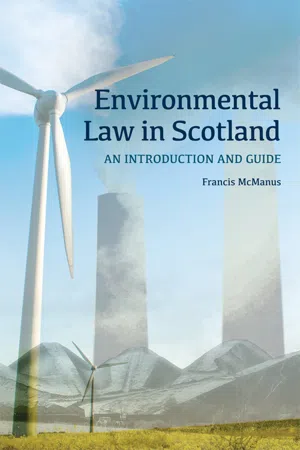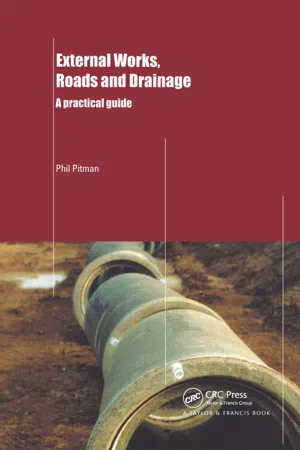Technology & Engineering
Environmental Protection Act 1990
The Environmental Protection Act 1990 is a UK legislation that aims to protect the environment and human health by regulating the management and disposal of waste, controlling pollution, and addressing contaminated land. It provides the legal framework for waste management and pollution control, including provisions for licensing and enforcement. The Act also outlines responsibilities for businesses and individuals in preventing environmental harm.
Written by Perlego with AI-assistance
Related key terms
1 of 5
4 Key excerpts on "Environmental Protection Act 1990"
- eBook - PDF
Advanced Electrical Installation Work
City and Guilds Edition
- Trevor Linsley(Author)
- 2019(Publication Date)
- Routledge(Publisher)
The legislation dealing with the environment has evolved for each part – air, water, land noise, radioactive substances. Where organizations’ activities impact upon the environmental laws they are increasingly adopting environmental management systems which comply with ISO 14001. Let us now look at some of the regulations and try to see the present picture at the beginning of the new millennium. Environmental Protection Act 1990 In the context of environmental law, the Environmental Protection Act 1990 was a major piece of legislation. The main sections of the Act are: Part 1 Integrated pollution control by HM Inspectorate of Pollution, and air pollution control by Local Authorities Part 2 Wastes on land Part 3 Statutory nuisances and clean air Part 4 Litter Part 5 Radioactive Substances Act 1960 Part 6 Genetically modified organisms Part 7 Nature conservation Part 8 Miscellaneous, including contaminated land. The Royal Commission of 1976 identified that a reduction of pollutant to one medium, air, water or land, then led to an increase of pollutant in another. It therefore stressed the need to take an integrated approach to pollution control. The processes subject to an integrated pollution control are: ● Air emissions. ● Processes which give rise to significant quantities of special waste; that is, waste defined in law in terms of its toxicity or flammability. Definition The environment describes the world in which we live, work and play; it relates to our neighbourhood and surroundings and the situation in which we find ourselves. This chapter has free associated content, including animations and instructional videos, to support your learning. When you see the logo, visit the website below to access this material: www.routledge.com/cw/linsley 59 Environmental technology systems Environmental technology systems 2 ● Processes giving rise to emissions to sewers or ‘Red List’ substances. - Michael Speegle(Author)
- 2012(Publication Date)
- Cengage Learning EMEA(Publisher)
SUMMARY The Environmental Protection Agency (EPA) was established in 1970 to protect the envi-ronment from pollution. Initially, the EPA focused on recycling and cleaning up open dump sites, but today the government has passed over 12 environmental laws that impact air, wa-ter, and land. These laws hold the manufacturers responsible for the hazardous wastes they generate from cradle to grave . The Clean Water Act of 1972 affects processing industries in at least two major ways. It re-quires a company to have a water permit and it regulates plant wastewater. The Clean Air Act also affects processing industries. Control and disposal of hazardous waste became a function of the EPA through the Resource Recovery and Conservation Act. RCRA was designed to establish a national program to protect the nation’s natural resources from im-proper handling and storage of hazardous wastes. Anyone who generates, transports, treats, stores, or disposes of hazardous waste must comply with RCRA. The Toxic Substances Control Act was designed to regulate commerce by requiring testing and necessary restric-tions on certain chemical substances. Copyright 2012 Cengage Learning. All Rights Reserved. May not be copied, scanned, or duplicated, in whole or in part. Due to electronic rights, some third party content may be suppressed from the eBook and/or eChapter(s). Editorial review has deemed that any suppressed content does not materially affect the overall learning experience. Cengage Learning reserves the right to remove additional content at any time if subsequent rights restrictions require it. Chapter 20 ● Environmental Protection Agency (EPA) 274 REVIEW QUESTIONS 1. (T/F) Process employees are responsible for protecting the environment inside their facility and outside it. 2. is a term that means from the time the chemical is manufactured until it is properly disposed of. 3. makes an employee liable for environmental fines and penalties should they fail to perform their job correctly.- eBook - PDF
Environmental Law in Scotland
An Introduction and Guide
- Francis McManus(Author)
- 2016(Publication Date)
- Edinburgh University Press(Publisher)
However, such an uncoordinated approach to regulation is condu-cive to practical problems. Currently the Pollution Prevention and Control Act 1999 makes provision for the Scottish Environment Protection Agency (SEPA) to regulate installations which have the potential to pollute the environment. 248 Environmental Law in Scotland effluent is retained in settling tanks prior to being discharged into a water-course. However, the filters at the outlet from the tank becomes blocked, the upshot of which is that the watercourse becomes polluted. The water pollution would require to be regulated by another agency. This problem in environmental regulation was recognised by the Royal Commission on Environmental Pollution in 1976. 2 The first attempt which was made by Parliament to deal holistically with environmental pollution – that is to say, which took into account the environment as a whole – was the Control of Pollution Act 1974 (COPA) which dealt with waste, water, noise and atmospheric pollution. A good example of such a holistic approach to regulating pollution can be illus-trated in the Act’s approach to waste disposal. Under Part 1 of COPA, 3 a waste disposal authority, when it was considering whether to grant a waste licence, was required to refer the proposal to the relevant river purification authority and also to take into account representations which were made by the latter. The move to a more integrated approach to pollution control contin-ued in the form of the Environmental Protection Act 1990 (EPA). 4 The EPA has been described as the most significant British legislative effort so far, to achieve a comprehensive and all-embracing system of control over all (or at least most) aspects of certain potentially polluting processes. 5 In essence, the EPA dealt with processes and discharges which affect all environmental media. - eBook - PDF
External Works, Roads and Drainage
A Practical Guide
- Phil Pitman(Author)
- 2001(Publication Date)
- CRC Press(Publisher)
44 External Works, Roads and Drainage - A Practical Guide 2.9 Environmental Protection Act 1990 This Act came about to improve the control of pollution arising from industrial and other processes. It strengthens powers from earlier legislation for sites causing a threat or nuisance from contamination and sets out the frameworks for DPC (Integrated Pollution Control) and the duty of care with respect to wastes. The aim of both of these (IPC and the duty of care) is to prevent future contamination by using effective control measures. ITie Act also covers pollution from former landfill sites by empowering waste regulation authorities to deal with the pollution. 2.10 Construction (Design and Management) Regulations 1994 The Construction (Design and Management) Regulations 1994 came about to improve health and safety for all those involved in a construction project. Since 1974, clients and designers have had statutory duties to deal with the health and safety issues which affect their works. Previous construction regulations created the impression that only contractors could affect the safety of their operatives and as a result, clients and designers tended to leave health and safety issues to the contractors. A study of fatal accidents in the construction industry, however, drew the conclusion that over 60% of accidents were due to decisions made before any works began on site. The Construction (Design and Management) Regulations 1994 became law ? in December 1994 and were implemented in March 1995. The equivalent Regulations in Northern Ireland are the Construction (Design and Management) Regulations (Northern Ireland) 1995 (SI 1995/209). The regulations apply to a wide definition of construction work. They are not restricted to the construction of new buildings or structures or contracts with construction companies and can equally apply interdepartmentally within companies. The CDM Regulations are based around the general duties of the Health and Safety at Work, etc.
Index pages curate the most relevant extracts from our library of academic textbooks. They’ve been created using an in-house natural language model (NLM), each adding context and meaning to key research topics.



